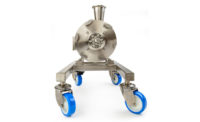“Innovation” means different things to different people. Some believe it is a synonym of “continuous improvement.”
“Innovation” means different things to different people. Some believe it is a synonym of “continuous improvement.” I believe these two terms are very different.
Continuous improvement provides incremental, positive benefits in an organization using existing tools and approaches. Innovation utilizes new ideas, technology and scientific concepts or the combination of existing ideas, technology and scientific concepts in novel ways to create unique products and processes. Apple Computer Inc.’s iTunes, iPod and iPad certainly are innovations in the electronic gadgets market, which have resulted in Apple being the world’s highest-valued company.
Dairy industry innovation will not occur without a culture of innovation that drives new solutions to existing challenges. Such a culture will also recognize new product solutions that consumers and customers are not even aware they need. Think about 3M’s Post-it notes or intelligent cell phones (and 3G and 4G networks).
Do we in the dairy industry have a Steve Jobs, Apple’s leader, who can not only create a culture of innovation, but demand it? Everyone has the ability to be an innovator; we just need to be willing to have a vision of the future, then use innovation to take us there.
Past examples of U.S. dairy industry innovations include the chug-style, grab-and-go milk bottle. It changed the entire pattern and image of milk consumption. Other examples include string cheese and reduced-temperature churning of ice cream. Membrane technology is a processing innovation that allows fracturing of whole milk into components, which create new innovative products.
In the near future, dairy product innovations are likely to fall in the following categories:
• Cross-over foods, associated with a single culture but are gaining popularity because of health benefits, flavor and visual appeal. Example: Greek yogurt
• New food, “invented” and popularized locally, then spreading regionally, nationally and finally internationally. Example: Artisanal cheeses
• Hybrid food, consisting of unique combination of foods from two or more existing “mainstream” foods, but with new and unique health benefits, flavor or visual appeal. Example: Macaroni and cheese
• Modified preparation food, which changes the traditional preparation by a consumer to render it ready-to-eat. Example: Microwave popcorn
• Existing foods in novel packaging. Examples: square-gallon plastic milk containers and plastic film-wrapped single slices of cheese
Some dairy processing innovations on the horizon that will also improve product safety include:
• The “living” processing plant. Managers will install advanced and integrated wireless sensor systems throughout the processing plant to provide real-time information, allowing rapid processing adjustments, reducing ingredient and product loss and production downtime, driving finished product consistency and improving product safety. Wireless sensor and control systems allow for a rapid reorganization of equipment on the plant floor without the time delay associated with running new hard-wired electrical cabling. An additional benefit is to reduce the time plant supervisors and workers spend entering production data, freeing them up to do their “real” jobs.
• Artificial intelligence for data management. This entails dedicated software to upload, organize and analyze plant operational information. Today’s dairy plant managers are overwhelmed with data so the plant is managed by exception. Only when a parameter is exceeded or an alarm is triggered are processes checked and adjusted. Using data management software with artificial intelligence capabilities can provide an early warning of developing problems. Dairy companies need to be installing and using dedicated LIMS (laboratory information management systems) software, PIMS (plant information management systems) software and ERM (enterprise report management) software together, producing meaningful reports for senior management.
• Alternative pasteurization technology. To improve the taste appeal of drinking milk, reduce energy consumption, retain protein characteristics and reduce “cooked” flavor defects, alternatives to heat pasteurization of milk are badly needed. Actually, they already exist. Such alternatives include UV light treatment, membrane filtration and electric pulse treatment. The primary blocks to using this technology in the United States are large capital investment in HTST pasteurization units and regulatory requirements at the state and FDA level. The dairy industry as a group needs to drive alternative pasteurization technology by piloting it, working with regulators to modify regulations restricting its use and installing the innovative technology in dairy plants. Success will result in new product and ingredient opportunities, which will drive additional growth in the industry.
A serious impediment to dairy industry innovation is the outdated dairy standards of identity enforced by the U.S. Food and Drug Administration. The U.S. dairy industry needs to work together to convince FDA that these 30- to 40-year-old regulations need to be updated. Such updating will allow dairy industry innovators to develop new product, contributing to the growth of the industry.
Innovation is one of those rare concepts that almost everyone supports, but only a few do anything about. To become the world leader, the U.S. dairy industry needs to adopt a culture of innovation, develop a clear vision of the future and use innovation to get there. n
Allen R. Sayler is vice president, food safety, technology and regulatory solutions of Randolph Associates Inc. allen.sayler@raiconsult.com. H. Randolph Inc.’s QA Studio is a LIMS software system that fully integrates into plant and dairy company PIMS and ERM software systems. To learn more, contact Andrena Schermerhorn, 775- 232-4856 or andrena.schermerhorn@raiconsult.com.
Get our new eMagazine delivered to your inbox every month.
Stay in the know on the latest dairy industry trends.
SUBSCRIBE TODAYCopyright ©2024. All Rights Reserved BNP Media.
Design, CMS, Hosting & Web Development :: ePublishing


